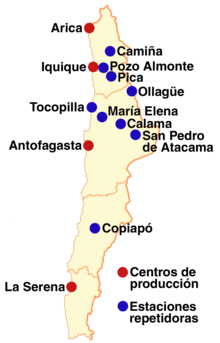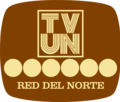Telenorte
Telenorte was a Chilean Television network launched in 1966 and closed in 2001. The network had stations in Arica, Iquique, Antofagasta and La Serena.
| Telenorte | |
|---|---|
 | |
| Launched | November 11, 1966 |
| Closed | October 17, 2018 |
| Owned by | Universidad Católica del Norte (1966-1995) Compañía Radio Chilena S.A (1995-2001) |
Availability | |
| Terrestrial | |
| Analog (Arica) | 11 |
| Analog (Iquique) | 12 |
| Analog (Antofagasta) | 4 |
| Analog (La Serena) | 5 |
History
1966-1995
Telenorte emerged in April 1982, when the Radio and Television Network of then University of the North was privatised, although its original name was Educational Network of the University of the North (Red Educativa de la Universidad del Norte), with a single frequency (Channel 3 in Antofagasta) which started in definitive form on 14 February 1973, although experimental transmissions began on November 11, 1966.[1] In that premiere broadcast, attended by the then rector of the University of the North, Carlos Aldunate, writers Andrés Sabella, Marta Blanco and María Elena Gertner, and sports commentator Julio Martínez, the latter through a program recorded on Santiago's Canal 13.[2] On March 18, 1967, after its experimental tests, at 20:55 Channel 3 began regular broadcasts with an act that was attended by Economy Minister of the Eduardo Frei Montalva administration, Domingo Santa María Santa Cruz.[3] These broadcasts were suspended in April 1969 -due to an agreement with the emerging Televisión Nacional de Chile that would arrive to the city in July of that year-[4] and were resumed on February 14, 1973, as part of the celebrations of the anniversary of the Chilean landing on Antofagasta (part of the Pacific War).[5]
In the city of Iquique the broadcasts began on May 21, 1976 and in the city of Arica on June 6 of that same year. The regional network was established in May 1977 and its first milestone was to join the transmission of the first Telethon, which aired in full color.[6] Iquique's Channel 12 conducted experimental transmissions in color between 1976 and 1977, which were captured by some of the few receivers in color and had had a different standard to which Chile later adopted. On 14 April 1978, Channel 3 of Antofagasta and Channel 8 of Calama and Chuquicamata began broadcasting their first 4 programs in color: Nocaut (boxing), Toqui (education), El Fantástico Mundo del Deporte and Show Musical.[7]
When the network was created, it began an era of transmissions in deferred with Canal 13 of Santiago, via microwave, broadcasting live, the highest rated programs like Sábado gigante, Martes 13 or sports broadcasts like World Cups and Olympic Games, which previously they were only tape-delayed.
Telenorte quickly became the alternative of information and entertainment, with emphasis on regional issues, since through its stations, offered programs and local newscasts. Even with the acquisition, at the mid-eighties, of a truck with microwave transmission system, they could make local transmissions from exteriors, like artistic events and football matches.
The last broadcasting agreement between Telenorte and Santiago's Canal 13 was for the 1988 plebiscite, since the following year ended the affiliation contract with the Santiago network because the latter had contemplated reach northern cities by its own satellite signal, which was completed in 1989. For example, in Antofagasta the arrival of Canal 13 took place on July 8, 1989.[8]
Alternatively, Telenorte signed a contract with Channel 11 of the then Television Corporation of the University of Chile (today Chilevisión), also from Santiago, which expired soon. In March 1990, with the signing of the new statutes of the Catholic University of North (Universidad Católica del Norte, UCN), Telenorte became a corporation and its first president was Iván Simunovic.[9]

On March 6, 1991 the National Television Council of Chile authorized to start broadcasts of Telenorte in La Serena and Coquimbo,[10] which began on 15 November 1992. In 1991 Telenorte broadcast live matches of the Copa América held in Chile. Later at the beginning of 1993, Telenorte made an agreement with La Red to broadcast most of their programs, putting and end to the agreement with Channel 11 since the latter announced its expansion nationwide in mid-1993, a product of the new owners at the time. All this lasted until 1994 when their original signals coming from Santiago arrived in the northern cities. Finally in the same year, Telenorte signed another contract with UCV Televisión and transmitted few programs of this channel and programs of local production, complemented with certain cultural programs produced by European broadcasters.
In 1995, the result of a financial crisis, UCN stopped being the majority owner of Telenorte, transgressing his administration to Radio Chilena SA Company, which became the new owner of this channel. The new company has developed plans for technical intermediation and also boosting local production through its stations. Following this, his studies and transmissions would be closed, starting in Iquique, Antofagasta and then finally in La Serena, leaving only his studies in Arica from 1998 to 2001, the year closed the channel.
Arica signal (VHF Frequency 10) was only for this city, while the Iquique (VHF Frequency 12) it was also for Pozo Almonte, Pica and Camiña (4 VHF frequency). The Antofagasta signal was relayed in Tocopilla -city in which began broadcasting on September 9, 1983-[11] María Elena, Pedro de Valdivia (VHF frequency 5), Calama, Chuquicamata (VHF frequency 8), San Pedro de Atacama, Ollagüe (frequency 12 VHF) -which arrived in May 1984-, and Copiapó (VHF frequency 5). The sign of La Serena and Coquimbo (VHF frequency 5) was only for these two cities.
Along with the television station, a radio chain was inaugurated on FM stations, called Radio Sol FM.
After 1995
In 1995, Universidad Católica del Norte ceased to be owner and when ownership passed into the hands of Compañía Radio Chilena S.A.
The network entered into bankruptcy, closing studios in Iquique in 1996, La Serena in 1997, Antofagasta in 1998. The Arica station closed in 2001, ending the network.
On December 31, 2001 UCV TV took over Telenorte, giving the Valparaíso station coverage in northern Chile. However, the signal was shut down in 2005.
That same year, the Telenorte signal was acquired by the company Alfa Tres, owner of Telecanal.
Logos
 1977-1982.
1977-1982. 1982-1995.
1982-1995. 1995-2000.
1995-2000. 2000-2001.
2000-2001.
References
- María de la Luz Hurtado (1988). "Historia de la televisión chilena (1959-1973)" (in Spanish). Archived from the original on 1 February 2012. Retrieved 19 June 2011.
- Antonio Freire (29 November 1966). "¡Tv en Antofagasta!". Ecran (in Spanish). Retrieved 19 June 2011.
- "Telenorte: Comienza la televisión en Antofagasta". La Estrella de Antofagasta (in Spanish). 25 January 2016. Retrieved 15 February 2016.
- "LA TELEVISIÓN DEL ESTADO DE CHILE Y SU INTEGRADORA EXPANSIÓN NACIONAL POR EL EXTREMO NORTE" (PDF) (in Spanish). Retrieved 31 August 2015.
- "Telenorte sale a hacerle competencia a TVN". La Estrella de Antofagasta (in Spanish). 7 March 2016. Retrieved 7 March 2016.
- "Nacimiento y caída de la imagen del norte". La Estrella de Arica (in Spanish). 18 November 2001. Retrieved 31 August 2015.
- "Llega la tele en colores". La Estrella de Antofagasta (in Spanish). 11 April 2016. Retrieved 11 April 2016.
- "También pasó en 1989". La Estrella de Antofagasta (in Spanish). 27 June 2016. Retrieved 29 June 2016.
- "La Universidad Católica del Norte". La Estrella de Antofagasta (in Spanish). 4 July 2016. Retrieved 4 July 2016.
- Consejo Nacional de Televisión (6 March 1991). "Otorga concesión de radiodifusión televisiva". LeyChile (in Spanish). Retrieved 19 January 2016.
- "Llega la tele al interior". La Estrella de Antofagasta (in Spanish). 16 May 2016. Retrieved 16 May 2016.